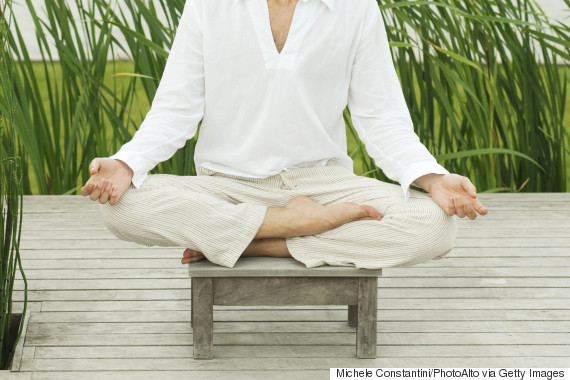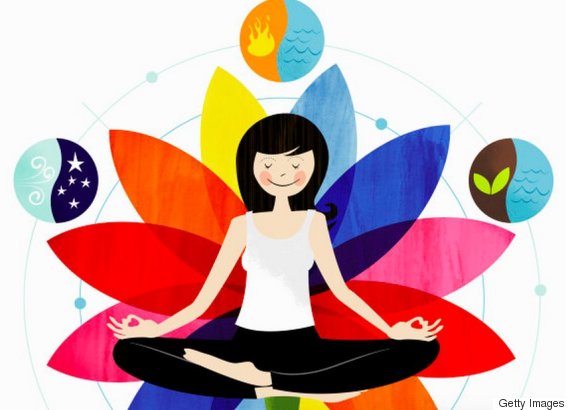New to meditating? It can be confusing. Not new to meditating? It can still be confusing.
The practice of meditation is said to have been around for thousands of years — and yet, in the last few, especially in America, it seems that everyone knows at least one person who has taken on the ancient art of de-stressing.
Because it has been around for so long and because there are many different types of meditation, there are some essential truths you should know before you too take the dive into meditation or mindfulness (or both). Take a look at the suggestions below.
1. You don’t need a mantra (but you can have one if you want).

It has become common for people to confuse mantra with the idea of an intention or specific words to live by. A motto. But the actual word “mantra” means something quite different. Man means mind and tra means vehicle. A mantra is a mind-vehicle. Mantras can be used in meditation as a tool to help your mind enter (or stay in) your meditation practice.
Other types of meditation use things like sound, counting breaths or even just the breath itself as a similar tool. Another way to think about a mantra is like an anchor. It anchors your mind as you meditate and can be what you come back to when your thoughts (inevitably) wander.
2. Don’t expect your brain to go blank.
One of the biggest misconceptions about meditation is that your mind is supposed to go blank and that you reach a super-Zen state of consciousness. This is typically not true. It’s important to keep in mind that you don’t have to try to clear thoughts from your brain during meditation.
The “nature of the mind to move from one thought to another is in fact the very basis of meditation,” says Deepak Chopra, a meditation expert and founder of the Chopra Center for Wellbeing. “We don’t eliminate the tendency of the mind to jump from one thought to another. That’s not possible anyway.” Depending on the type of meditation you learn, there are tools for gently bringing your focus back to your meditation practice. Alternatively, some types of meditation actually emphasize being present and mindful to thoughts as they arise as part of the practice.
3. You do not have to sit cross-legged or hold you hands in any position.

You can sit in any position that is comfortable to you. Most people sit upright in a chair or on a cushion. Your hands can fall gently in your lap or at your sides. It is best not to lie down unless you’re doing a body scan meditation or meditation for sleep.
4. Having said that, it’s also okay if you do fall asleep.
It’s very common to doze off during meditation and some believe that the brief sleep you get is actually very restorative. It’s not the goal, but if it’s a byproduct of your meditation, that is OK. Other practices might give tricks on how to stay more alert if you fall asleep (check out No. 19 on these tips from Headspace), like sitting upright in a chair. In our experience, the relaxation that can come from meditation is a wonderful thing — and if that means a mini-snooze, so be it.
5. There are many ways to learn.
With meditation becoming so available to the masses, you can learn how to meditate alone, in a group, on a retreat, with your phone or even by listening to guided meditations online. Everyone has a different learning style and there are plenty of options out there to fit individual needs. Read our suggestions for how to get started.
6. You can meditate for a distinct purpose or for general wellness.

Some meditation exercises are aimed at one goal, like helping to ease anxiety or helping people who have trouble sleeping. One popular mindfulness meditation technique, loving-kindness meditation, promotes the positive act of wishing ourselves or others happiness. However, if you don’t have a specific goal in mind, you can still reap the benefits of the practice.
7. Meditation has so many health perks.
Meditation can help boost the immune system, reduce stress and anxiety, improve concentration, decrease blood pressure, improve your sleep, increase your happiness, and has even helped people deal with alcohol or smoking addictions.
8. It can also physically change your brain.
Researchers have not only looked at the brains of meditators and non-meditators to study the differences, but they have also started looking at a group of brains before and after eight weeks of mindfulness meditation. The results are remarkable. Scientists noted everything from “changes in grey matter volume to reduced activity in the ‘me’ centers of the brain to enhanced connectivity between brain regions,” Forbes reported earlier this year.
Those who participated in an eight week mindfulness program also showed signs of ashrinking of the amygdala (the brain’s “fight or flight” center) as well as a thickening of the pre-frontal cortex, which handles brain functions like concentration and awareness.
Researchers also looked at brain imaging on long-term, experienced meditators. Many, when not in a state of meditation, had brain image results that looked more like the images of a regular person’s brain while meditating. In other words, the experienced meditator’s brain is remarkably different than the non-meditator’s brain.
9. Oprah meditates.

So does Paul McCartney, Jerry Seinfeld, Howard Stern, Lena Dunham, Barbara Walters, Arianna Huffington and Kobe Bryant. Oprah teams up with Deepak Chopra for 21-day online meditation experiences that anyone can join, anywhere. The program is free and the next one begins in March 2015.
10. It’s more mainstream than you might think.
Think meditation is still a new-age concept? Think again. GQ magazine wrote their own guide to Transcendental Meditation. Time’s February 2014 cover story wasdevoted to “the mindful revolution” and many big companies, such as Google, Apple, Nike and HBO, have started promoting meditation at work with free classes and new meditation rooms.
11. Mindfulness and meditation are not the same thing.
The two are talked about in conjunction often because one form of meditation is called mindfulness meditation. Mindfulness is defined most loosely as cultivating a present awareness in your everyday life. One way to do this is through meditation — but not all meditation practices necessarily focus on mindfulness.
Mindfulness meditation is referred to most often when experts talk about the health benefits of meditation. Anderson Cooper recently did a special on his experience practicing mindfulness with expert Jon Kabat-Zinn for “60 Minutes.”
12. Don’t believe yourself when you say you don’t have time to meditate.

While some formal meditation practices call for 20 minutes, twice a day, many other meditation exercises can be as short as five or 10 minutes. We easily spend that amount of time flipping through Netflix or liking things on Instagram. For some, it’s setting the morning alarm 10 minutes earlier or getting off email a few minutes before dinner to practice.
Another way to think about incorporating meditation into your daily routine is likening it to brushing your teeth. You might not do it at the exact same time each morning, but you always make sure you brush your teeth before you leave the house for the day. For those who start to see the benefits of daily meditation, it becomes a non-negotiable part of your routine.
13. You may not think you’re “doing it right” the first time you meditate.
Or the second or the third. That’s OK. It’s an exercise that you practice just like sit-ups or push-ups at the gym. You don’t expect a six-pack after one day of exercise, so think of meditation the same way.
14. Take a step back.
Many meditation teachers encourage you to assess your progress by noticing how you feel in between meditations — not while you’re sitting down practicing one. It’s not uncommon to feel bored, distracted, frustrated or even discouraged some days while meditating. Hopefully you also have days of feeling energized, calm, happy and at peace. Instead of judging each meditation, try to think about how you feel throughout the week. Less stressed, less road rage, sleeping a little bit better? Sounds like it’s working.
